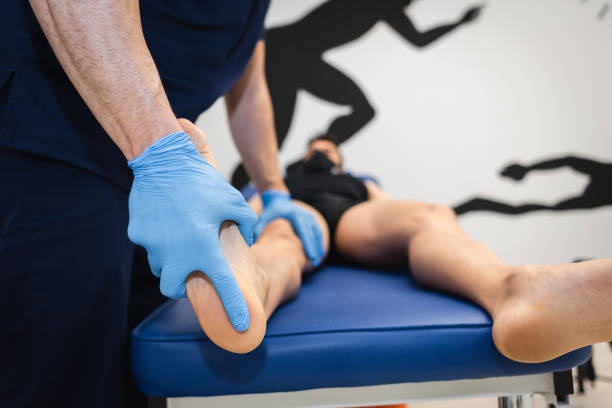Ankle Pain Statistics: Surprising Facts and Figures
Ankle pain is a common condition that affects people of all ages and backgrounds. It can be caused by various factors, including injuries, overuse, or underlying health conditions. According to the Centers for Disease Control and Prevention (CDC), ankle sprains are one of the most common musculoskeletal injuries in the United States, accounting for an estimated 2 million emergency department visits each year.
However, ankle pain is not limited to just sprains. Many other causes of ankle pain may surprise you. In this article, we will explore some surprising statistics and facts about ankle pain.
Understanding Ankle Pain: A Comprehensive Guide
Ankle discomfort arises from a variety of sources, ranging from mild overuse to intricate health conditions. Ankle sprains are often the primary offenders, occurring when there’s a sharp twist or turn that overextends or rips the supporting ligaments. Other prevalent causes encompass Achilles tendinitis, arthritis treatment, gout, bone fractures, and plantar fasciitis. For example, Achilles tendinitis impacts the hefty tendon that links the calf muscles to the heel, commonly seen in avid runners. Arthritis brings about joint soreness and stiffness, significantly hindering movement and overall life quality. Gout, another form of arthritis, is known for causing abrupt, intense pain episodes and swelling in the affected area. Identifying the exact cause of ankle discomfort is essential for devising effective treatment plans and initiating the healing process.

Ankle Treatment
Age and Gender Differences in Ankle Pain
Ankle pain can affect anyone, regardless of age or gender. However, certain demographic groups may be more prone to ankle pain than others. According to a study published in the Journal of Foot and Ankle Research, females are more likely to report ankle pain compared to males.
Additionally, the risk of ankle sprains is higher in younger individuals, with the highest incidence occurring between the ages of 15 and 24. As people age, the likelihood of ankle sprains decreases but the risk for other causes of ankle pain, such as osteoarthritis, increases.
Common Causes of Ankle Pain
As mentioned earlier, ankle sprains are a common cause of ankle pain. However, there are many other possible causes, including:
- Achilles Tendinitis: This condition is characterized by inflammation of the Achilles tendon, the large tendon connecting the calf muscles to the back of the heel bone. Often resulting from repetitive stress to the tendon, Achilles tendinitis is particularly common among runners and athletes who engage in sports that involve sudden starts and stops. Symptoms typically include pain and stiffness along the Achilles tendon in the morning, which may improve with mild activity but worsen with increased exercise intensity.
- Gout: Gout is a form of inflammatory arthritis triggered by uric acid crystal buildup in the joints. This leads to sudden, intense pain, redness, and swelling, primarily affecting the big toe but also targeting the ankle. Ankle gout causes severe discomfort, hindering mobility. The ankle pain is described as sharp and burning, peaking within 12-24 hours. Risk factors include a purine-rich diet (red meat, seafood, alcohol), obesity, high blood pressure, and certain medications. Management involves medication for acute pain relief and attack prevention, coupled with lifestyle changes to lower uric acid levels.
- Osteoarthritis as a Cause of Ankle Pain: Osteoarthritis, known as wear-and-tear arthritis, occurs when joint cartilage and underlying bone degrade due to aging and use over time. In the ankle, this condition can lead to pain, stiffness, and swelling, hindering daily activities like walking or climbing stairs. Symptoms often worsen with prolonged activity or by day’s end. Unlike rapid-onset arthritis like gout, osteoarthritis progresses slowly. Risk factors include age, prior joint injuries, obesity, and genetic predispositions. While no cure exists for osteoarthritis, treatments like physical therapy, pain relief medications, and surgery can help manage symptoms and enhance joint function.
- Rheumatoid Arthritis and Ankle Pain: Rheumatoid arthritis (RA) is an autoimmune disorder that targets joints, causing pain, stiffness, and swelling. Unlike osteoarthritis, which is degenerative, RA stems from the immune system attacking the body’s tissues, particularly in the synovium lining the joints. This attack leads to ankle discomfort as the inflamed synovium thickens, resulting in cartilage and bone damage over time. Symptoms of RA in the ankles include tenderness, warmth, and visible swelling in both ankles at once. While the cause of RA remains largely unknown, genetics and environmental factors are considered influential. Though incurable, RA can be managed with treatments like medication, physical therapy, and surgery to enhance life quality.
- Tarsal Tunnel Syndrome: Tarsal tunnel syndrome occurs when the posterior tibial nerve in the ankle’s inner side is compressed. Symptoms include tingling, burning sensation, or electric shock-like feelings in the ankle, foot, or toes, along with radiating pain. Similar to carpal tunnel syndrome but in the ankle, causes can range from injuries to systemic diseases like diabetes. Treatment involves RICE therapy, physical therapy, medication, and possibly surgery for severe cases.
Surprisingly, wearing high heels has also been linked to a higher risk of ankle pain. According to a study published in the Journal of Foot and Ankle Surgery, wearing high heels for more than 5 hours a day can lead to chronic ankle pain.

Ankle Pain Treatment
Transforming Daily Experiences: The Effects of Ankle Pain
While ankle pain may appear to be a small hurdle, its influence on daily experiences cannot be underestimated. Research featured in the British Journal of Sports Medicine highlights that people enduring chronic ankle discomfort face substantial challenges, including reduced engagement in physical activities and an elevated incidence of depressive symptoms when contrasted with individuals free from such pain.
The repercussions of ankle pain extend into the professional sphere as well. Insights from a study in the Journal of Occupational Rehabilitation reveal that employees grappling with persistent ankle issues not only experience diminished satisfaction in their jobs but also report greater absenteeism and presenteeism (the practice of coming to work despite illness or injury), showcasing the broader impact of this condition on both personal well-being and professional fulfillment.
Exploring Solutions for Ankle Discomfort
Ankle discomfort is a common issue, yet, surprisingly, a substantial number of people overlook seeking professional foot doctor advice for it. A study conducted by the American Podiatric Medical Association reveals a curious trend: while over half of the citizens in the U.S. (54%) report having dealt with foot or ankle discomfort, a mere 27% have consulted with a healthcare provider for solutions.
Addressing ankle discomfort is crucial, particularly when it persists or hampers day-to-day activities. A variety of treatments are available, ranging from physical therapy and medication to bracing, or even surgery for more acute conditions.
Strategies for Minimizing Ankle Pain
Ensuring the prevention of ankle pain is crucial, with data suggesting that improper rehabilitation or a past history of ankle injuries contribute to approximately 70% of ankle sprains.
Effective measures to mitigate the risk of ankle discomfort include:
- Opting for shoes that provide adequate support
- Performing warm-up routines and stretches before engaging in sports or exercise
- Reducing the frequency of wearing high heels and limiting their use to brief intervals
- Incorporating exercises into your routine to strengthen the muscles around the ankle
- Steering clear of activities known to exert excessive strain on the ankle, especially if susceptible due to prior injuries or specific conditions

Prevention of Ankle Pain
Treatment and Recovery Times
When it comes to foot treatments, the approach and recovery time can vary significantly depending on the cause and severity of the condition. Generally, for mild injuries such as minor sprains or strains, home remedies and over-the-counter pain relief can be effective, with recovery times ranging from a few days to several weeks. However, more severe cases, such as fractures or severe ligament damage, may require medical intervention, including surgery, followed by physical therapy.
Recovery times for these more severe cases can vary widely, often taking several months, and depend greatly on the individual’s adherence to their rehabilitation program and the body’s natural healing process. For example, a mild sprain may heal within 2-4 weeks with proper rest and care, while a severe sprain or fracture might not fully heal for 6 months to a year. Physical therapy plays a crucial role in recovery, aimed at restoring strength, flexibility, and stability to the ankle, thereby ensuring a return to full functionality.
Ultimately, the key to treatment and recovery lies in an accurate diagnosis, followed by a tailored approach that considers the specific needs and health status of the individual. It’s also important for individuals to follow their healthcare provider’s advice closely and avoid rushing the recovery process, as doing so can lead to complications or chronic issues down the line.
In conclusion, ankle discomfort remains a prevalent and impactful issue, affecting not only the physical but also the mental and professional realms of an individual’s life. Understanding the various conditions that lead to ankle pain, as well as the importance of seeking professional advice, is crucial for effective management and prevention. By adopting the recommended strategies for minimizing ankle discomfort, individuals can significantly enhance their quality of life. It’s essential to prioritize ankle health through proper footwear, exercise, and care to forestall the adverse effects of ankle conditions. Remember, a proactive approach towards maintaining ankle health can lead to a lifetime of mobility and well-being.
Flagstaff Foot Doctors: Anthony Rosales DPM
https://www.google.com/maps?cid=8835841318590452161
421 N Humphreys St, Flagstaff, AZ 86001, United States
(928) 774-4825
https://flagstafffootandankle.com/
